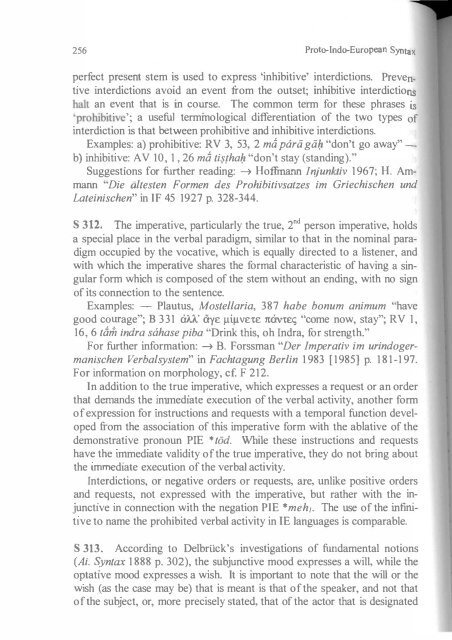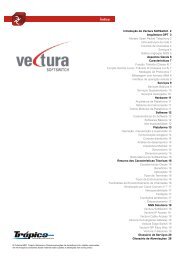Create successful ePaper yourself
Turn your PDF publications into a flip-book with our unique Google optimized e-Paper software.
256 Prol()-lnd()-European Syntaxperfect pr se ? t stem is used to express 'inhibitive' interdictions. Preven_tlve mterdlctlons avoid an event from the outset; inhibitive interdictio?alt an .eve t that is in co se. The common term for these phrases . prohibltlve ; a useful termmological differentiation <strong>of</strong> the two types <strong>of</strong>mterdlctlon 15 that between prohibitive and inhibitive interdictions.EXa mPles: a) prohibitive: V 3, 53, 2 ma parii gii/.l "don't go away" -b) inhibItIve: AV 10, 1,26 ma ti!ha/.l "don't stay (standing)."Suggestlons for further reading: H<strong>of</strong>finann !,yunktiv 1967; H. Ammann"Die ditesten Formen des Prohibilivsatzes im Griechischen undLateinischen" in IF 45 1927 p. 328-344.S 312. The perative, particularly the true, 2 "" person perative, holdsa special . plce m the verbal paradigm, similar to that in the nominal paradIgmoccupIed by the vocative, which is equally directed to a listener and.WIth which th imperative shares the formal characteristic <strong>of</strong> having singularform which 15 composed <strong>of</strong> the stem without an ending with no sign<strong>of</strong> its connection to the sentence.Examples: - Plautus, Mostellaria, 387 habe bonum animum "havegood c ? age"; B,331 aU' aye !It!lvete !l(XV'tEC; "come now, stay"; RV I,16, 6 tam mdr sahase p iba "Drink this, oh Indra, fo r strength."For further informatIOn: B. Forssman "Der !mperaliv im urindogerman schen erbaisystem" in Fachtagung Berlin 1983 [1985] p. 181-197.For mformatIon on morphology, ct: F 212.In addition to the true .perative, which expresses a request or an orderthat de ds the lnunedlate execution <strong>of</strong> the verbal activity, another form<strong>of</strong> expressIon for mstructions and requests with a temporal function developedfrom the association <strong>of</strong> this perative form with the ablative <strong>of</strong> thedemonstratIve pronoun PIE 'tad. While these instructions and requestshave the medlate validIty <strong>of</strong> the true perative, they do not bring aboutthe munedlate executIon <strong>of</strong> the verbal activity.Interdictions, or negative orders or requests, are, unlike positive orders?D d equests, not expressed with the perative, but rather with the inJunctIve m connection with the negation PIE 'mehl• The use <strong>of</strong> the infinitIveto name the prohibited verbal activity in IE languages is comparable.S 313. According to Delbriick's investigations <strong>of</strong> fundamental notions(AI. Syntax 1888 p. 302), the SUbjunctive mood expresses a will, while theoptatIve mood expresses a wish. It is portant to note that the will or theWIsh (as the case may be) that is meant is that <strong>of</strong> the speaker, and not that<strong>of</strong>the subject, or, more precisely stated, that <strong>of</strong> the actor that is designated'•• \ Morphosyntax'l/erlJGby ttbrouge nb its own derivational verbal form, namely, the desiderative. Forh orninative form. The wish <strong>of</strong> the subject was originally expressed. . .da (Character <strong>of</strong> the Moods 1956), the characteTlStlc propertIes are? OO uaIization' for the subjunctive (p. 69ff.), and 'eventuality' for the optaVIS (p 52). According to A. Scherer ("Die ursprungliche Funktion des.t . b'Konjunktivs" in Fachtagung Be n 1969 [197] p. 99-106, the su unctIvedraWS the conclusion from a gIven Ituatlo (p. 101) :'The subjunctIvewould then indicate a state <strong>of</strong> affiurs, which accordmg to the reievantjacts, may be accepted factual (i . .e. concluded from the CITcumstances tobe necessarily true), while the mdlcatlve reports what the speaker kMWS( believes to know), or asserts as a fact. The optatIve characterIZesmT., IPmerely that the state <strong>of</strong> affairs was thought." (p. 101). he ongma rotolodo-Europeancategories 'optative' and 'subjunctive' fused in Latin.Suggestions for further reading: Delbriick Conjuncliv und Optativ1871' Hahn Subjunctive and Optative 1953; Gonda Indo-EuropeanMoods 1956; K. Strunk "Zur diachronischen Morphosyntax des Konjunktivs"in Kolloquium Kuhner Amsterdam 1986 [1988] p. 291-312. For information on morphology, cf. F 206f.1) 'The subjunctive, which originally indicates the future, has two functions:J 0 its prospective function, it serves to express things that happen in the future,while in its voluntative function, it indicates the will <strong>of</strong> the speaker. 'The subjunctive is used to express his will when he considers that it is within his powerto bring about the verbal action. A declaration <strong>of</strong> will in a strict sense is onlypossible when the speaker has direct influence on events, such that that whichis desired may also be executed. This means that a true expression <strong>of</strong> will mayonly be in the first person singular, while all other cases are equally requests . .Ifthe first person subjunctive is taken as a request made <strong>of</strong> oneself, a connectIonto the second and third person subjunctive is possible in which the speaker hasno direct influence on the reali7ation <strong>of</strong> the verbal action, so that the statementmay only be understood as a request. A further connection may be made withthe I" person plural, in which the speaker communicates his own will, and atthe same time directs a request to others.2) Examples: _ a) I sg.: Plautus Bacchides 1049 quod perdundumst properemperdere ''what may be lost, J wiIVwant to hurry up and lose"; u 296ID' iJ:ye Ot KOt EyriJ &00 eivtOv "thus I wi\Vwant to give a gift <strong>of</strong> welcomealso to him"; RV 10, 39, 5 purii vii". virya pra bravii jane "your earlierheroic deeds I wi\Vwant to announce to all people"; RV 6, 59, 1 pra nu vociisutesu vam ''On the occasion <strong>of</strong> the pressing, I thus wi\Vwant to announce theheric deeds <strong>of</strong> both <strong>of</strong> you." - b) 1 pI.: Q 601 vuv liE !lVllcrW!1ESO OOpltOU257





